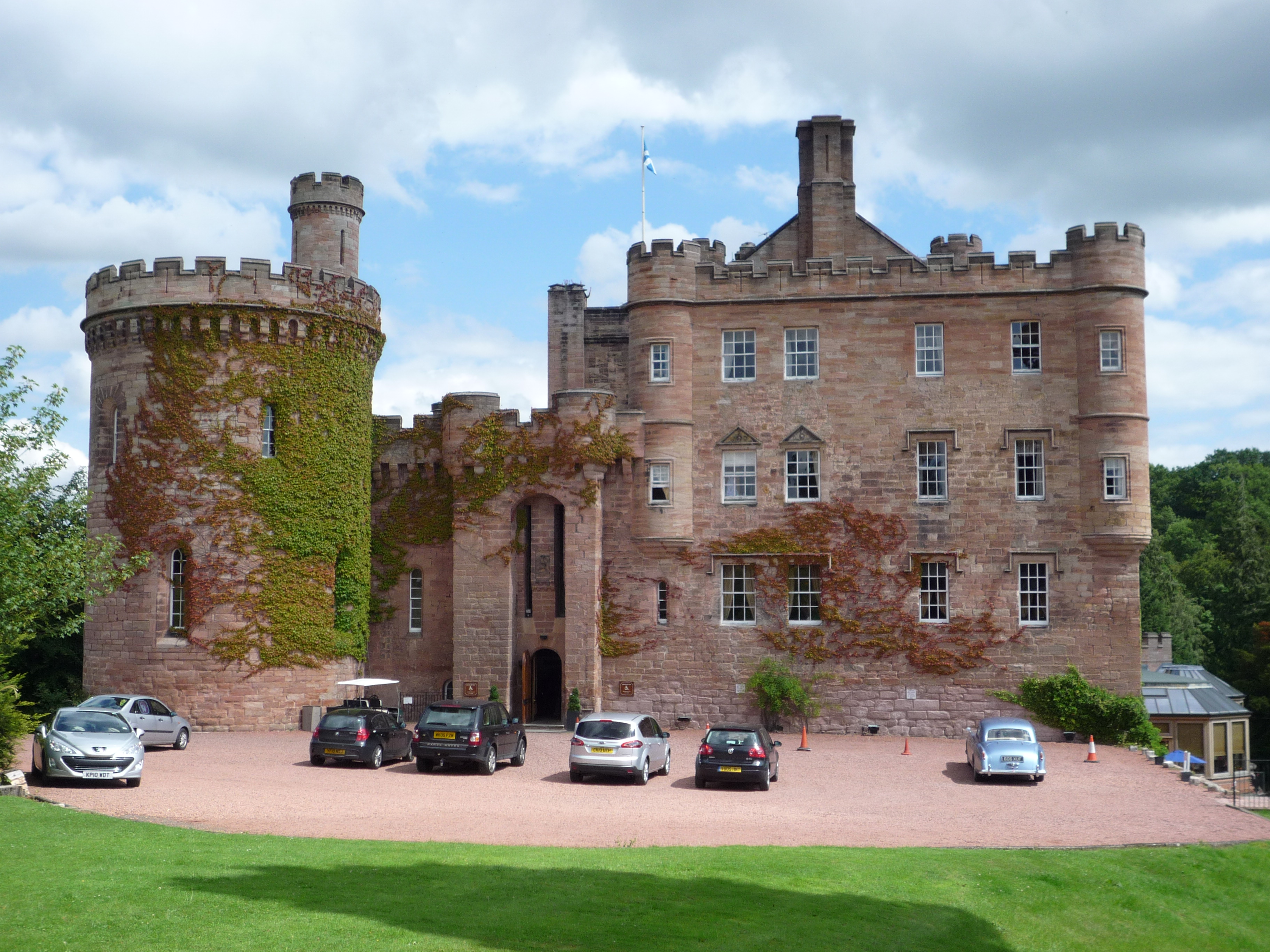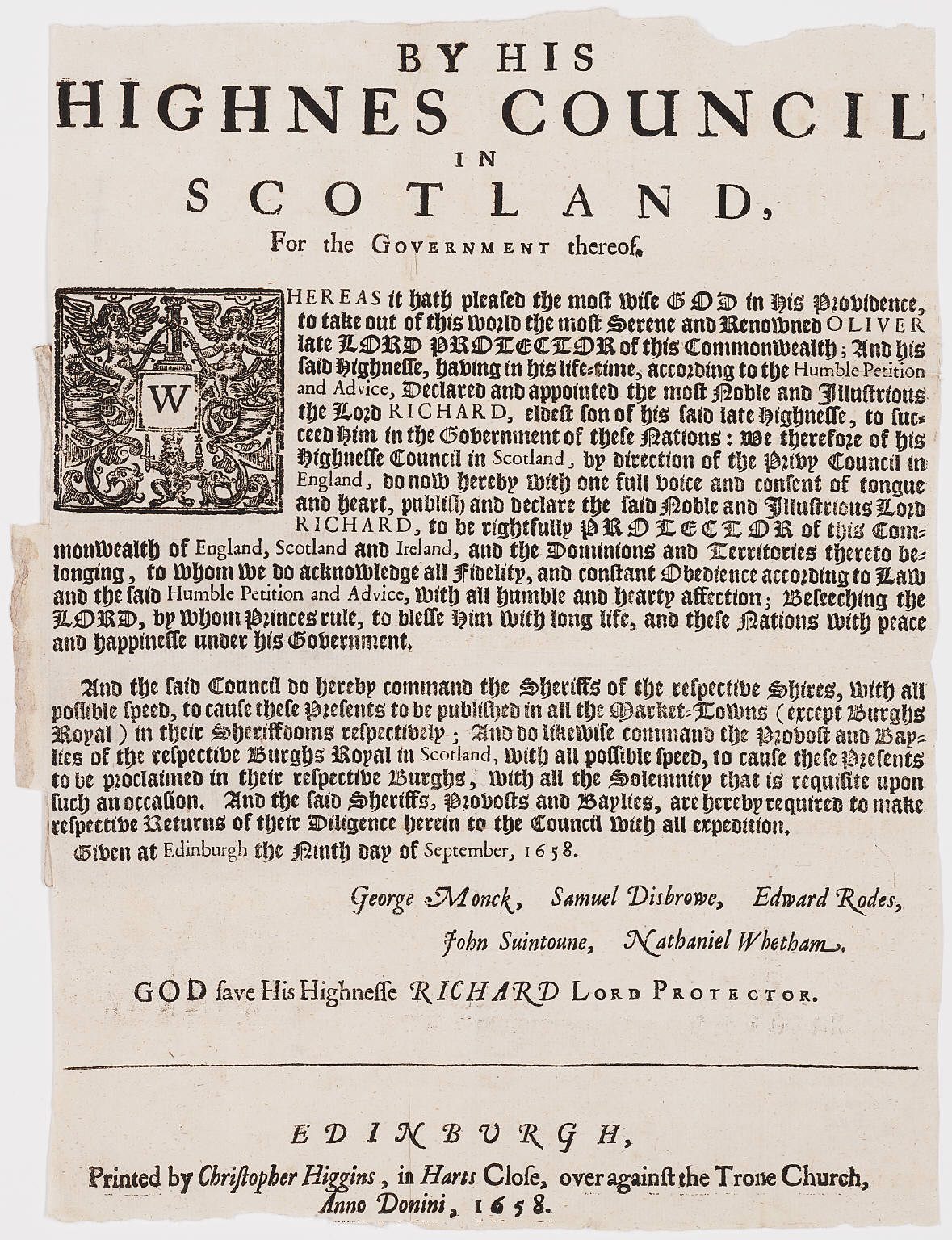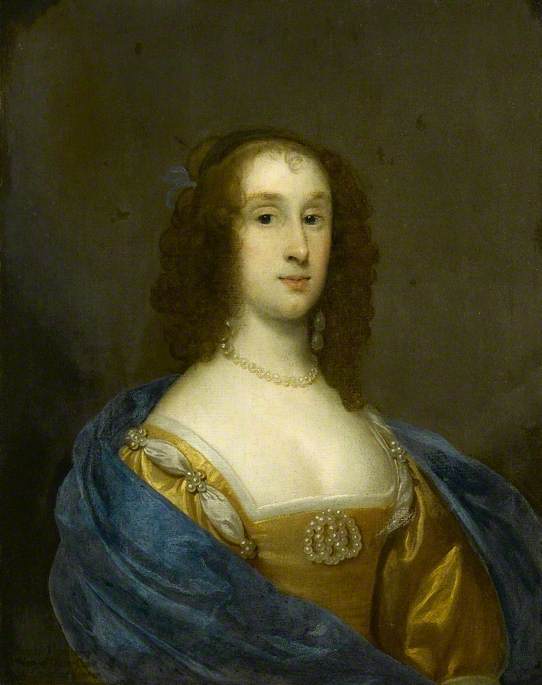|
Patrick Gillespie (minister)
Patrick Gillespie (1617–1675) was a Scottish minister, strong Covenanter, and Principal of the University of Glasgow by the support of Oliver Cromwell. Life He was third son of John Gillespie, minister of Kirkcaldy, by his wife Lilias, daughter of Patrick Simson, minister of Stirling; and brother of George Gillespie and the Quaker writer, prophet and preacher Lilias Skene. He was baptised 2 March 1617, was educated at the University of St Andrews, where he graduated in 1635, became minister of the second charge of Kirkcaldy in 1642, and of the High Church of Glasgow in 1648. From that time he took a very prominent part in public affairs, first as an extreme covenanter, and next as a friend and supporter of Cromwell. He strenuously opposed the " Engagement" for the rescue of Charles I, helped to overthrow the government that sanctioned it, and advocated severe measures against all ' malignants.' He considered the terms made with Charles II unsatisfactory, and after the ba ... [...More Info...] [...Related Items...] OR: [Wikipedia] [Google] [Baidu] |
Principal Of The University Of Glasgow
The Principal of the University of Glasgow is the working head of the University, acting as its chief executive. He is responsible for the day-to-day management of the University as well as its strategic planning and administration. The Principal is appointed by the University Court and is President of the Senate, the University's supreme academic body. The Principal is normally also created Vice-Chancellor of the University, conferring on him the degree-awarding powers of the Chancellor. Professor Sir Anton Muscatelli succeeded Sir Muir Russell as Principal on 1 October 2009 retrieved 2 October 2009 History From around the foundation of the University in the 15th century there existed the office of the Principal Regent, who was the senior regent of the University, with juris ...[...More Info...] [...Related Items...] OR: [Wikipedia] [Google] [Baidu] |
John Sharp (archbishop)
John Sharp (16 February 1645 – 2 February 1714), English divine who served as Archbishop of York. Biography Memoirs of the Secret Services of John Macky Esq.: John Archbishop of York, is Dr. Sharp, he was a Rector of St Giles in the Fields, in the Reign of King James; when, preaching warmly against Popery, he was silenced, and the Bishop of London ( Dr. Compton) suspended from his office, for not turning him out. He was made by King William Archbishop of York; and this Queen hath made him her Lord Almoner. He is one of the greatest Ornaments of the Church of England, of great Piety and Learning; a Black Man, and fifty-five Years old. John Sharp was born at Bradford, the eldest son of Thomas Sharp, a salter, and Dorothy Weddal. His father was a puritan who enjoyed the favour of Thomas Fairfax and inculcated in him Calvinist, Low Church, doctrines, while his mother, being a strong royalist, instructed him in the liturgy of the Book of Common Prayer. He was educated at Br ... [...More Info...] [...Related Items...] OR: [Wikipedia] [Google] [Baidu] |
1675 Deaths
Events January–March * January 5 – Franco-Dutch War – Battle of Turckheim: The French defeat Austria and Brandenburg. * January 29 – John Sassamon, an English-educated Native American Christian, dies at Assawampsett Pond, an event which will trigger a year-long war between the English American colonists of New England, and the Algonquian Native American tribes. * February 4 – The Italian opera ''La divisione del mondo'', by Giovanni Legrenzi, is performed for the first time, premiering in Venice at the Teatro San Luca. The new opera, telling the story of the "division of the world" after the battle between the Gods of Olympus and the Titans, becomes known for its elaborate and expensive sets, machinery, and special effects and is revived 325 years later in the year 2000. * February 6 – Nicolò Sagredo is elected as the new Doge of Venice and leader of the Venetian Republic, replacing Domenico II Contarini, who had died 10 days ea ... [...More Info...] [...Related Items...] OR: [Wikipedia] [Google] [Baidu] |
1617 Births
Events January–June * February 27 – The Treaty of Stolbovo ends the Ingrian War between Sweden and Russia. Sweden gains Ingria and Kexholm. * April 14 – Second Battle of Playa Honda: The Spanish navy defeats a Dutch fleet in the Philippines. * April 19 – The town of Uusikaupunki ( sv, Nystad, lit. "New Town") was founded by King Gustavus Adolphus of Sweden. * April 24 – Encouraged by Charles d'Albert, seventeen-year-old Louis XIII, king of France, forces his mother Marie de Medici, who has held ''de facto'' power, into retirement and has her favourite, Concino Concini, assassinated. * June 5 – Ferdinand II, Archduke of Inner Austria, is elected King of Bohemia. Ferdinand's forceful Catholic counter-reformation causes great unrest, amongst the Protestants and moderates in Bohemia. July–December * September 1 – The weighing ceremony of Jahangir is described by the first English ambassador to the Mughal court, Sir Thomas Roe. * S ... [...More Info...] [...Related Items...] OR: [Wikipedia] [Google] [Baidu] |
Robert Baillie
Robert Baillie (30 April 16021662) was a Church of Scotland minister who became famous as an author and a propagandist for the Covenanters. University of Glasgow (multitab page-but image is of James Baillie (1723–1778)) In Baillie's engagement with the theological and liturgical controversies of the mid-Seventeenth Century, Baillie sought to reconcile his strong belief in maintaining unity with a firm adherence to a Christian doctrine dictated by the divine 'truth' revealed in Scripture. Two large volumes of Baillie's sermons survive in manuscript. He was also conscientious in ensuring that copies were made of his outgoing correspondence and other documents with a view to creating a body of evidenc ... [...More Info...] [...Related Items...] OR: [Wikipedia] [Google] [Baidu] |
Robert Ramsay (principal)
Robert Ramsay (1594–1651) was a minister of the Church of Scotland who served as Principal of Glasgow University. Life He was born at Dalhousie Castle south of Edinburgh the son of George Ramsay (1571-1629) and his wife Margaret Colville. He was educated at Glasgow University graduating MA in 1618. He began work as a schoolteacher in Irvine, but then from 1625 served as a Church of Scotland minister at Dundonald, South Ayrshire. In December 1640 he translated to Blackfriars Church in Glasgow. In April 1647 he moved to St Mungo's Church, Glasgow .''Fasti Ecclesiae Scoticanae''; vol. 7; by Hew Scott ; In 1648 he was elected Rector of Glasgow University and was appointed Principal on 28 August 1651 in place of John Strang (who had resigned). However, he died on 4 September of the same year, after only a few days in office. He is buried in Canongate Kirkyard in Edinburgh. Family He married twice: firstly Marion Mure of Airdhill granddaughter and heir of William Mure of ... [...More Info...] [...Related Items...] OR: [Wikipedia] [Google] [Baidu] |
James Guthrie (minister)
James Guthrie (1612? – 1 June 1661), was a Scottish Presbyterian minister. Cromwell called him "the short man who would not bow." He was theologically and politically aligned with Archibald Johnston, whose illuminating 3 volume diaries were lost until 1896, and not fully published until 1940. He was exempted from the general pardon at the restoration of the monarchy, tried on 6 charges, and hanged in Edinburgh. James Guthrie was born about 1612 and said to be son of Guthrie of that ilk. He graduated with an M.A. from St. Andrew's University. He subsequently became a regent in St Leonard's College, St Andrews. He was one of those whom the Assembly, 16 December 1638, found ready to supply vacancies. He was not ordained until a few years later when he was called to Lauder in 1642, where he stayed for 7 years. He was selected with three others to wait upon Charles I at Newcastle in 1646 with a letter from the Assembly. He preached before Parliament on 10 January 1649, and was th ... [...More Info...] [...Related Items...] OR: [Wikipedia] [Google] [Baidu] |
Ormiston
Ormiston is a village in East Lothian, Scotland, near Tranent, Humbie, Pencaitland and Cranston, located on the north bank of the River Tyne at an elevation of about . The village was the first planned village in Scotland, founded in 1735 by John Cockburn (1685–1758), one of the initiators of the Agricultural Revolution. Name The word Ormiston is derived from a half mythical Anglian settler called ''Ormr'', meaning 'serpent' or 'snake'. 'Ormres' family had possession of the land during the 12th and 13th centuries. Ormiston or 'Ormistoun' is not an uncommon surname, and ''Ormr'' also survives in some English placenames such as Ormskirk and Ormesby. The latter part of the name, formerly spelt 'toun', is likely to descend from its Northumbrian Old English and later Scots meaning as 'farmstead' or 'farm and outbuildings' rather than the meaning 'town'. There was an "Ormiston" in Berwickshire, near Linton, where the legend of the Worm of Linton was related to land owne ... [...More Info...] [...Related Items...] OR: [Wikipedia] [Google] [Baidu] |
Stirling Castle
Stirling Castle, located in Stirling, is one of the largest and most important castles in Scotland, both historically and architecturally. The castle sits atop Castle Hill, an intrusive crag, which forms part of the Stirling Sill geological formation. It is surrounded on three sides by steep cliffs, giving it a strong defensive position. Its strategic location, guarding what was, until the 1890s, the farthest downstream crossing of the River Forth, has made it an important fortification in the region from the earliest times. Most of the principal buildings of the castle date from the fifteenth and sixteenth centuries. A few structures remain from the fourteenth century, while the outer defences fronting the town date from the early eighteenth century. Before the union with England, Stirling Castle was also one of the most used of the many Scottish royal residences, very much a palace as well as a fortress. Several Scottish Kings and Queens have been crowned at Stirling, in ... [...More Info...] [...Related Items...] OR: [Wikipedia] [Google] [Baidu] |
English Restoration
The Restoration of the Stuart monarchy in the kingdoms of England, Scotland and Ireland took place in 1660 when King Charles II returned from exile in continental Europe. The preceding period of the Protectorate and the civil wars came to be known as the Interregnum (1649–1660). The term ''Restoration'' is also used to describe the period of several years after, in which a new political settlement was established. It is very often used to cover the whole reign of King Charles II (1660–1685) and often the brief reign of his younger brother King James II (1685–1688). In certain contexts it may be used to cover the whole period of the later Stuart monarchs as far as the death of Queen Anne and the accession of the Hanoverian King George I in 1714. For example, Restoration comedy typically encompasses works written as late as 1710. The Protectorate After Richard Cromwell, Lord Protector from 1658 to 1659, ceded power to the Rump Parliament, Charles Fleetwood and J ... [...More Info...] [...Related Items...] OR: [Wikipedia] [Google] [Baidu] |
Richard Cromwell
Richard Cromwell (4 October 162612 July 1712) was an English statesman who was the second and last Lord Protector of the Commonwealth of England, Scotland and Ireland and son of the first Lord Protector, Oliver Cromwell. On his father's death in 1658 Richard became Lord Protector, but lacked authority. He tried to mediate between the army and civil society and allowed a Parliament containing many disaffected Presbyterians and Cavalier, Royalists to sit. Suspicions that civilian councillors were intent on supplanting the army were brought to a head by an attempt to prosecute a major-general for actions against a Royalist. The army made a threatening show of force against Richard and may have had him in detention. He formally renounced power nine months after succeeding. Although a Royalist revolt was crushed by the recalled civil war figure General John Lambert (general), John Lambert, who then prevented the Rump Parliament from reconvening and created a Committee of Safety, Lam ... [...More Info...] [...Related Items...] OR: [Wikipedia] [Google] [Baidu] |
Charles Fleetwood
Charles Fleetwood (c. 1618 – 4 October 1692) was an English Parliamentarian soldier and politician, Lord Deputy of Ireland in 1652–1655, where he enforced the Cromwellian Settlement. Named Cromwell's Lieutenant General for the Third English Civil War, Fleetwood was thereafter one of his most loyal supporters throughout the Protectorate. After the Lord Protector's death, Fleetwood was initially supportive of his brother-in-law Richard Cromwell, but turned against him and forced him from power. Together with his colleague John Lambert he dominated government for a little over a year before being outmaneuvered by George Monck. At the Restoration he was included in the Act of Indemnity as among the twenty liable to penalties other than capital, and was finally incapacitated from holding any office of trust. His public career then closed. Early life Charles Fleetwood was the third son of Sir Miles Fleetwood of Aldwinkle, Northamptonshire, and of Anne, daughter of Nicholas Luke ... [...More Info...] [...Related Items...] OR: [Wikipedia] [Google] [Baidu] |







